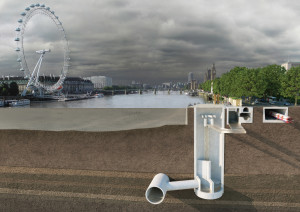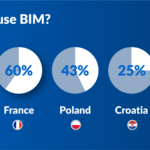News - Construction News
The future is digital

Propelled by the BIM mandate, technology within construction is taking leaps and bounds into the future. With construction traditionally seen as a slow moving beast, it’s evolution since the introduction of digital technology has been rapid, with companies seeing the benefit of investing in these emerging technologies.
Mott MacDonald is a leader in the sector and keen to enhance the digitisation of construction where it can be.
We spoke to Mert Yesugey, Senior Project Manager at the company, about the developments in technology and how Mott MacDonald is applying the techniques.
Mott MacDonald is an engineering, management and development consultancy involved in solving some of the world’s most urgent social, environmental and economic challenges. The firm also helps governments and businesses plan, deliver and sustain their strategic goals, responds to humanitarian and natural emergencies and improves people’s lives.
Mert currently leads on the Thames Tideway East project, which won Mott MacDonald’s internal BIM Award in 2016 and Bentley’s Be Inspired Award for BIM Advancements in Project Delivery this year. He has extensive management experience in design delivery and collaborating with both clients and contracting organisations in the global design and build environment. A keen promoter of innovation, Mert’s work on the Thames Tideway digital delivery design project saw him win Mott MacDonald’s internal Group Project Manager of the Year Award for 2017. He also represents the consultancy on i3P, the UK Infrastructure Industry Innovation Platform.

We asked Mert about the developing use of technology in construction.
“Construction has always been reliant upon technology in some way or another,” he says, “whether that be advanced materials, construction vehicles or tunnel boring machines. However, because construction projects take place over such long timescales they carry enough residual risk to mean they rarely drive transformational technology. The pace of technological development in consumer-facing industries is far more rapid.”
What about the newer technologies that are emerging, such as virtual and augmented reality?
“We are using VR on live projects, largely to look at the operational use of infrastructure during the design phase. On Thames Tideway East, this has been with Thames Water’s operations and maintenance teams, while we have also been looking at the end users on a major metro project in Australia. All our work is undertaken with a view to create better outcomes for society, not just looking for ways to streamline the delivery process.”
Such is the take-up and interest in the emerging technology, the company is currently deploying VR facilities across its major global offices, such as London, Singapore, Dubai and New Jersey, as well as a number of others across the globe. In the UK, many teams and offices are adopting the technology in different ways, from dedicated suites in Bristol and Blackburn to more agile deployments within some of the delivery teams.
The investment is a direct response to the reaction of clients, who have been highly receptive to the technologies deployed on projects, explains Mert. While there are often front-end challenges, such as demonstrating measurable benefits and identifying areas to maximise the return on investment, once these are overcome, the company sees significant uptake from clients and increased upskilling of the teams involved. With every new project delivered, these technologies are becoming the norm.
And what are the benefits that are gained from VR and ‘virtual construction’ technologies?
“When targeted to specific construction challenges, there has been great benefit in demonstrating the feasibility of complicated construction methodologies during design development,” says Mert. “On Thames Tideway East, VR was used to appreciate the scale and complexity of the construction of very large precast concrete sections, which was time dependant. This aided the design development of connection details where access is limited by tidal windows. The key challenge of VR is making sure it is deployed in a timely fashion during the feasibility phase of a project to maximise its benefits.”
And the more it is used, the less it is seen as a gimmick.
“The drive from the consumer market is so much bigger and the level of immersion is far more compelling than it was even a year ago,” adds Mert. “Immersion is not just visualisation. By adding elements such as spatial sounds and temperature changes, the brain is tricked into believing that what it is experiencing is real, to the point where the user is not only seeing the world from the cab of a crane, but feeling what it is like to be the crane driver. The user experiences vertigo, can see but not hear the banksman. This true sense of reality ultimately generates far more value to the overall outcome than a 3D model on a screen can.”
The adoption of these new technologies is going hand in hand with the development of BIM and the ability to run at higher levels, he says. “Immersive technologies offer a much more intuitive and natural way to interact with information and digital assets than computer monitors and drawings. The opportunities for enhanced engagement with non-engineering stakeholders is clearly a vector for the demand for BIM from infrastructure owners and operators. It provides a much more tangible and impactful way to demonstrate and deliver the value of BIM to ultimate end users.”
By embracing the BIM Mandate, both consultants and contractors are able to forge ahead with the digitisation of construction.
Mert continued: “This is typical of the wider digital transformation effort, however, and adoption of new technologies is just one indicator of innovative and future-facing businesses. I don’t think we require a separate, concerted effort to cause a wholesale shift in culture across the supply chain, market forces will see to that.”
And it’s not just the larger companies that should be pursuing this integration.
“SMEs and smaller businesses are well placed to embrace VR and AR, ” he says. “The nature of their leadership and smaller breadth of internal communications can allow rapid adoption, should their leadership choose to embrace it. The cost of equipment is also dropping rapidly, which, combined with the democratisation of software, is removing barriers to entry. At the same time, these organisations are potentially limited in wider application by their own boundaries. However, SMEs and smaller businesses can work with organisations such as Mott MacDonald to understand the benefits and help each other progress. As a larger organisation, Mott MacDonald can operate at different speeds, making sure projects are successfully delivered to standard processes while at the same time innovating by utilising new technologies on a global scale to maximise adoption and boost the expertise of staff.”
And not only are the pre-construction stages benefiting from the development of technologies. Sensor technology is starting to come into play, giving facilities managers and engineers information that would not be available otherwise.
Mert agreed: “I think there is still great potential in sensor technology. Our industry has a long way to catch up compared to others when it comes to collecting data and I feel that this is preventing productivity from being improved when delivering built infrastructure. As designers, we get limited feedback from the actual assets we have designed and built. However, there is great potential in sensor technology to provide us with the appropriate data to improve the way we design, build and operate. I would like to think that one day, our designs will be based on real-world data rather than empirical and dated design codes and standards.”
When talking about the digitisation of construction, it is impossible to avoid mentioning the BIM mandate. Whether the mandate has been successful can be determined by the steps the industry is taking, rather than the full adoption of higher levels.
Mert explains: “Was the BIM Mandate successful? It depends on how you view success. If it means that we are now using BIM level 2 by default throughout the value chain, that all three million people in the UK construction industry are fluent with BIM ways of working and that we are seeing the step change in efficiency that was hoped for, then it hasn’t been wholly successful. However, if it is viewed as the UK construction industry taking meaningful steps towards a more progressive, digital future and is leading the world in the adoption of a structured approach to information management through the delivery of capital projects, then I think it has been very successful.”
The government is pushing for higher levels across all public sector projects, whether this will further drive the change remains to be seen.
“Change is most effective when there is a compelling need for it,” says Mert. “Sharing positive stories about real savings that have been achieved will certainly help. However, perhaps there also needs to be a stick to follow on from the carrot for those not making the necessary changes.”
“We have all the technologies we need to make BIM level 2 a reality,” he continued, “it is the mindsets and behaviours we lack. There could certainly be improvements in the way the leading software providers’ products interact with each other, but this should not prevent us from making significant progress with the technology that is already available. For SMEs such as product manufacturers, there is a burning need for industry-wide product data templates so that they can provide the same information to each client. There also needs to be a consensus on a realistic amount of graphical detail that is needed so that their products are adequately represented spatially. But again, these are not technological barriers.”
The benefits of BIM to the design process are well known, with 3D models allowing for supreme optioneering, which streamlines the delivery process and brings efficiency savings in materials, time and costs to the construction process. However, project-centric BIM can only go so far as the majority of an asset’s costs fall within its operational life.
Mert explained: “Asset lifecycle information management sees the physical, operational asset complemented by active management of information-rich models. This virtual asset uses intelligent data to streamline maintenance and optimise performance.”
He concluded: “The future is smart infrastructure. Assets are interconnected to each other and all other information sources, everything from social media and ticketing data to weather forecasts and traffic information, to optimise the performance of all infrastructure for the benefit of the ultimate customers.”
If you would like to read more articles like this then please click here.
Related Articles
More News
- Construction output decreased in February
23 Apr 24
The estimates show that monthly construction output is expected to have decreased 1.9% in volume
- Falling from height workplace injuries
22 Apr 24
Following the recent tragic news of Gogglebox star, George Gilbey's death is a stark reminder
- SMEs remain unprepared as cyber threats escalate
19 Apr 24
SMEs neglect cyber security, making them easy targets for a wide range of attacks, including






